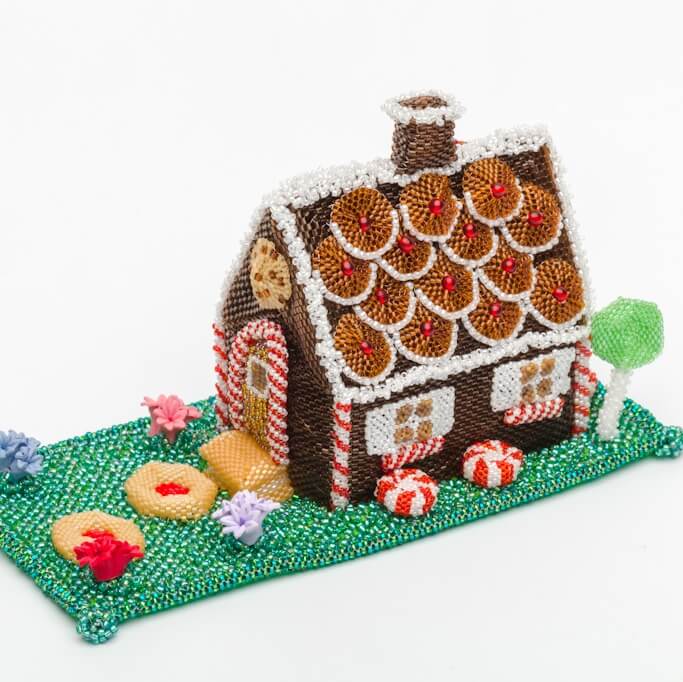
One of the questions I’m most often asked is where do the ideas for your beading designs come from? Mostly, I don’t really know. Sometimes I have an image in my head and feel a compulsion to make it in beads. Sometimes I want to experiment with a concept. Sometimes I see something in the world around me and think it might translate into a beading design. Sometimes the beads lead the way. Sometimes it is a combination of several of these things. One beading design that has proved very popular is my Gingerbread House and, interestingly, it has a clear story behind it, so I thought I would share it with you.
Where do beading designs originate?
In the case of the gingerbread house, the idea came from a conversation that I had with my publisher, Vivienne Wells and the photographer, Jonathan Bosley, whilst we were on the photoshoot for my Bead Flowers and Wedding Bouquets book. Somehow the conversation had turned to the topic of beading competitions. I had recently won best in show at the British Bead Awards with ‘My Little Cake Shop’, a series of cakes that were taken from my ‘Beaded Cakes in Miniature‘ book. Funnily enough, we had been talking about where my ideas originate and what I was going to come up with for the next British Bead Awards. I didn’t have a very clear idea, but said I had been thinking about fairytales a lot, so maybe there might be something there. We started throwing around ideas on that theme – some of them very good and some of them frankly a little silly. Then, as conversations do, the theme took another twist and expanded onto other things, like houses and garden sheds! We had a really good laugh together before getting back to the photography. I certainly didn’t have a clear idea at that point, but something about the idea of houses and sheds appealed to my love of geometric and three-dimensional beadwork. Somehow this became intertwined with the fairytales and the gingerbread house idea was born.
How do beading designs become reality?
The literal answer to that question is: through a lot of hard work and many hours spent beading and unpicking, sometimes in equal measure! However, before the beads come out, all designers will do some sort of planning. Every designer has their own way of doing this. Some like to play with the beads, some draw sketches. I do a lot of planning in my head and when it comes to a big project, I like to let ideas simmer for a while before I turn to the beads. I very rarely sketch any of my beading designs. Usually when I do make a sketch from which to work, the end result in beads is something entirely different as the beads take me on a path that I had not imagined. So I tend to start with some fairly loose ideas in my head and then see where the beads take me.
If I am making something like the gingerbread house that i s an actual recognisable object, I will do some research. My beading design has grown throughout the internet era, so for me, that research usually involves searching for photos online. I mostly search through google images – just typing in search terms that are variations on the theme to see what comes up. I used to paste these into a Powerpoint or Word file which I would then print out and sit beside me as I worked. Now, I am much more environmentally friendly! As soon as I heard about Pinterest, I knew this would be a great resource for me. I don’t use it to research images, but I have created a board there onto which I will Pin images that inspire me, so I no longer have to copy, paste and print out. I can sit with my laptop showing the board as I work. I never actually copy from an image, but seeing different i
s an actual recognisable object, I will do some research. My beading design has grown throughout the internet era, so for me, that research usually involves searching for photos online. I mostly search through google images – just typing in search terms that are variations on the theme to see what comes up. I used to paste these into a Powerpoint or Word file which I would then print out and sit beside me as I worked. Now, I am much more environmentally friendly! As soon as I heard about Pinterest, I knew this would be a great resource for me. I don’t use it to research images, but I have created a board there onto which I will Pin images that inspire me, so I no longer have to copy, paste and print out. I can sit with my laptop showing the board as I work. I never actually copy from an image, but seeing different i mages of a theme allows me to assemble my own ideas. You can pop over and take a look at the images I picked out for my Gingerbread House here….see if you can spot which went into the design I ended up with for the Gingerbread House beaded box! See how many of my other beading patterns you can link to my research board as well – I think every image currently on there has fed into a pattern that has been published on this website! And, if you want a little insight into what I might be planning next, keep an eye on the board to see what I pin to it…
mages of a theme allows me to assemble my own ideas. You can pop over and take a look at the images I picked out for my Gingerbread House here….see if you can spot which went into the design I ended up with for the Gingerbread House beaded box! See how many of my other beading patterns you can link to my research board as well – I think every image currently on there has fed into a pattern that has been published on this website! And, if you want a little insight into what I might be planning next, keep an eye on the board to see what I pin to it…
It is probably also worth saying that when I am choosing images for inspiration, I am looking at them in terms of beading, so they might appeal because they have a shape that I know I can recreate, or they might be ideas for colouring. My beadwork tends to be quite bright and bold I think, so I often choose images that have simple, bold colouring. For this reason, cartoon artwork can be quite good – it is like a caricature of the real thing, so has simplified and amplified the detail into something larger than life. This can be easier to reflect in beads.
The Gingerbread House Box
My original Gingerbread House was a three-dimensional project that took over two months to create. I made it specifically to enter into the British Bead Awards and I never had any intention of writing up the instructions. It was far too complicated for one thing. For another, I do like some of my beading designs to remain uniquely mine! Some of the ideas in it made their way into other smaller patterns: you might notice the Jammie Dodgers in the front path, which became a necklace pattern. Then there are the mints that sat alongside the sides of the house – these became this bracelet pattern.
This, like all my big competition pieces, had been a project designed to stret ch my skills in a new direction. I wanted to make something that was three-dimensional, but would be free-standing, so the beads are not supported by any kind of frame or other object. It is entirely the combination of beading techniques that allows this house to stand on its own. So, having achieved my personal ambition to meet that challenge, it was lovely to have my work recognised with a third prize award.
ch my skills in a new direction. I wanted to make something that was three-dimensional, but would be free-standing, so the beads are not supported by any kind of frame or other object. It is entirely the combination of beading techniques that allows this house to stand on its own. So, having achieved my personal ambition to meet that challenge, it was lovely to have my work recognised with a third prize award.
I then featured the gingerbead house as a photo in my book ‘Sweet Treats‘. I never imagined that it would create so much attention. However, I have been asked by a lot of people for a pattern for the Gingerbread House. For all the reasons outlined above, I knew there was no way it would be practical to make this actual beading design into a tutorial, but that didn’t mean no tutorial would emerge. For a while, I turned the idea round in my head. I wanted to maintain elements of the spirit of the original gingerbread house, so the sweets that decorated it and the fact that it was three-dimensional and free-standing, but I knew I had to simplify the ideas a lot to make them practical for a beading tutorial. Eventually I came up with the idea of turning the house into a beaded box, so it would have a practical reason for existing, not just ornamental. Then began the hard work of beading and writing up this design. The instructions ran to 17 pages and the house took me a couple of weeks to make, but this was far more practical than my original design. Yet, I didn’t have to compromise and make a poor copy – my Gingerbread House Beaded Box is currently one of my best sellers and I am very happy to see it taking on a life of its own. Speaking of which, I almost forgot to mention the other source of ideas for beading designs: evolution. Very often I will be making one project and thinking, ‘what if I did that instead?’…and so my next design begins to emerge. So how about a series of boxes themed on houses?…I’m thinking pretty little thatched cottage, maybe even a church…let me know what you think!


Wow! Loved reading about your process for such a project. The Gingerbread Box is an absolute work of art.
Emma @Beads Jar UK
Thanks Emma – that’s very kind of you! I’m glad you found the process interesting too – I know I am often asked how I come up with designs and I thought it would be interesting for me to start thinking a bit more about it and sharing that with all of you 🙂